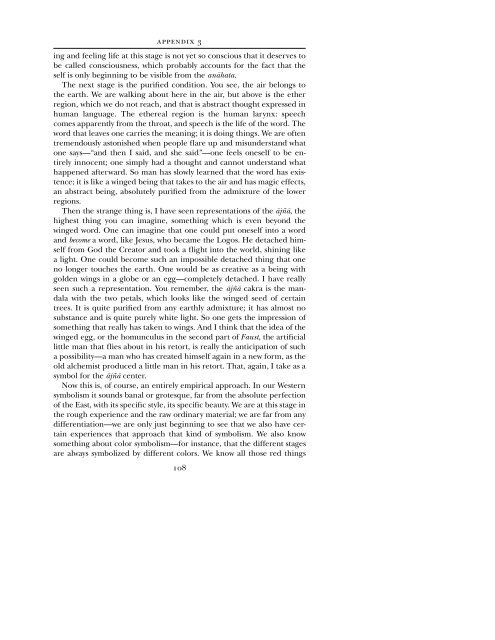CG JUNG - Countryside Anarchist
CG JUNG - Countryside Anarchist
CG JUNG - Countryside Anarchist
Create successful ePaper yourself
Turn your PDF publications into a flip-book with our unique Google optimized e-Paper software.
APPENDIX 3<br />
ing and feeling life at this stage is not yet so conscious that it deserves to<br />
be called consciousness, which probably accounts for the fact that the<br />
self is only beginning to be visible from the anvhata.<br />
The next stage is the purified condition. You see, the air belongs to<br />
the earth. We are walking about here in the air, but above is the ether<br />
region, which we do not reach, and that is abstract thought expressed in<br />
human language. The ethereal region is the human larynx: speech<br />
comes apparently from the throat, and speech is the life of the word. The<br />
word that leaves one carries the meaning; it is doing things. We are often<br />
tremendously astonished when people flare up and misunderstand what<br />
one says—“and then I said, and she said”—one feels oneself to be entirely<br />
innocent; one simply had a thought and cannot understand what<br />
happened afterward. So man has slowly learned that the word has existence;<br />
it is like a winged being that takes to the air and has magic effects,<br />
an abstract being, absolutely purified from the admixture of the lower<br />
regions.<br />
Then the strange thing is, I have seen representations of the vjñv, the<br />
highest thing you can imagine, something which is even beyond the<br />
winged word. One can imagine that one could put oneself into a word<br />
and become a word, like Jesus, who became the Logos. He detached himself<br />
from God the Creator and took a flight into the world, shining like<br />
a light. One could become such an impossible detached thing that one<br />
no longer touches the earth. One would be as creative as a being with<br />
golden wings in a globe or an egg—completely detached. I have really<br />
seen such a representation. You remember, the vjñv cakra is the mandala<br />
with the two petals, which looks like the winged seed of certain<br />
trees. It is quite purified from any earthly admixture; it has almost no<br />
substance and is quite purely white light. So one gets the impression of<br />
something that really has taken to wings. And I think that the idea of the<br />
winged egg, or the homunculus in the second part of Faust, the artificial<br />
little man that flies about in his retort, is really the anticipation of such<br />
a possibility—a man who has created himself again in a new form, as the<br />
old alchemist produced a little man in his retort. That, again, I take as a<br />
symbol for the vjñv center.<br />
Now this is, of course, an entirely empirical approach. In our Western<br />
symbolism it sounds banal or grotesque, far from the absolute perfection<br />
of the East, with its specific style, its specific beauty. We are at this stage in<br />
the rough experience and the raw ordinary material; we are far from any<br />
differentiation—we are only just beginning to see that we also have certain<br />
experiences that approach that kind of symbolism. We also know<br />
something about color symbolism—for instance, that the different stages<br />
are always symbolized by different colors. We know all those red things<br />
108


